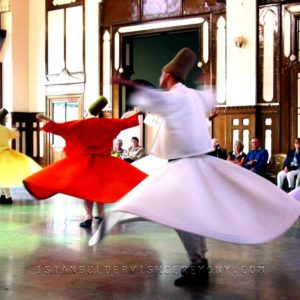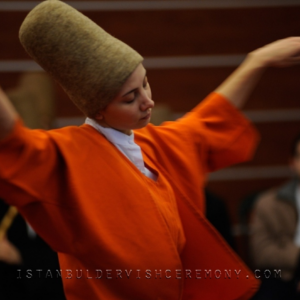Information About Sufism and Dervish Ceremony
Information About Sufim and Dervish Ceremony
Known to the west as Whirling Dervishes, the Mevlevi Order was founded by Mevlana Rumi in the 13th century. The Order wrote of tolerance, forgiveness, and enlightenment. They survive today as a cultural brotherhood. They are not theatrical spectacles but sacred rituals. The ritual of the Mevlevi sect, known as the sema, is a serious religious ritual performed by Muslim priests in a prayer trance to Allah. Mevlevi believed that during the sema the soul was released from earthly ties, and able to freely and jubilantly commune with the divine. Dervish literally means “doorway” and is thought to be an entrance from this material world to the spiritual, heavenly world. The Whirling Dervishes played an important part in the evolution of Ottoman high culture.
From the fourteenth to the twentieth century, their impact on classical poetry, calligraphy and visual arts was profound. Rumi and his followers integrated music into their rituals as an article of faith. Rumi emphasized that music uplifts our spirit to realms above, and we hear the tunes of the Gates of Paradise.
Rumi brought enthusiasm to hearts with his saintly characteristics ; he was a saint , spritual master , whose human mind had been bathed in light ; he cleanses hearts and minds of impurities and rescues them from duality.
He rejects nothing but rather unites , perfects and causes love. He is prejudiced toward none because he knows that everything is the manifestation and actualization of God and he reflects this as a spritual state to the mind and heart of man Mevlana is asuperior and saintly master . He is a system in himself , a life an order. He is a monument to spritually who , through his sublimity , displayed his moral values , his knowledge , wisdom love , intelligence , perception of God , behaviour , everything . His is the true representative of the prophets , the highest element and realization of love and intelligence.
“Man is the nost honorable of all creation.”
is one of his maxims.
The Exalted Mevlana embraced those of every language , creed and race or color ; he is the symbol of love peace , brotherhood, and tolerance.
The night of 17 December is the holiest in the Mevlevî calendar, a night of union, a wedding night (Şeb-i Arus), when Mevlana departed the mortal world to become one with He who loves and is loved. It is not a time to mourn but to rejoice: At my death do not lament our separation…As the sun and moon but seem to set,In reality this is a rebirth. Each year thousands of people from the far corners of the world, travel to Konya in response to Mevlana’s call of 735 years ago:
“Come, come again, whoever you are, come!
Heathen, fire worshipper or idolatrous, come!
Come even if you broke your penitence a hundred times,
Ours is the portal of hope, come as you are.”
To understand Mevlana one should read his works. It is suggested to start with his major work, The Masnavi . Mevlana’s books are translated to many languages and are among the best selling books of their sort all over the world. At present, Mevlana, better known there as Rumi, is the “best selling poet” in United States of America. The Essential Rumi by Coleman Barks has sold more than a quarter of a million copies and is one of the top 1000 best selling books at Amazon. It is by far the largest selling poem book ever!
Sufi Tradition & Mevlevi Order
Sufism is a mystical Muslim school of thought and aims to find love and knowledge through direct personal experience of Allah. Sufism, often referred to as the mystical dimension of Islam, was formerly understood in Orientalist scholarship as a spiritual movement that reached its apogee during the medieval period of Islamic history, with its crowning achievement being the brilliant literary productions in Arabic and Persian that became the classics of the Sufi tradition.
Many Sufi orders exist across the Muslim world. Sufis are “mystics” on the path to the Beloved (God). Most Sufis are Muslims, followers of the religion of Islam. Some Sufis (primarily in “the West”) are involved with other religions, or no formal religion — as directed by the higher source of wisdom within the human heart.
The Mevlevi, or Mevleviye, one of the most well-known of the Sufi orders, was founded in 1273 by Rumi’s followers after his death, particularly his son, Sultan Veled Celebi (or Çelebi, Chelebi) in Konya , from where they gradually spread throughout the Ottoman Empire. Today, Mevleviye can be found in many Turkish communities throughout the world but the most active and famous places for their activity are still Konya and Istanbul.
The Mevlevi were a well established Sufi Order in the Ottoman Empire, and many of the members of the order served in various official positions of the Caliphate. The centre for the Mevlevi order was in Konya, where Rumi is buried. There is also a Mevlevi monastery or dergah in Istanbul, near the Galata Tower, where the sema ceremony is performed and accessible to the public.
During Ottoman Empire era, the Mevlevi order produced a number of famous poets and musicians such as Sheikh Ghalib, Ismail Ankaravi (both buried at the Galata Mevlevi-Hane) and Abdullah Sari. Music, especially the ney, play an important part in the Mevelevi order and thus much of the traditional “oriental” music that Westerners associate with Turkey originates with the Mevlevi order. Indeed, if one buys a CD of Turkish Sufi music, chances are it will be Mevlevi religious music.
During the Ottoman period, the Mevlevi order spread into the Balkans, Syria, and Egypt (and is still practiced in both countries where they are known as the Mawlawi order). The Bosnian writer Mesa Selimovic wrote the book Death and the Dervish about a Mevlevi dergah in Sarajevo.
The Mevlevi Order is also linked to other Dervish orders such as the Qadiri (founded in 1165), the Rifa’i (founded in 1182), and the Kalenderis.
The Mevlevi Order was outlawed in Turkey at the dawn of the secular revolution by Kemal Atatürk in 1923.
The Mevlevi Sema Ceremony
Mevleviye are known for their famous practice of whirling dances. At their dancing ceremonies, or Sema, a particular musical repertoire called ayin is played. This is based on four sections of both vocal and instrumental compositions using contrasting rhythmic cycles and is performed by at least one singer, a flute-player (neyzen), a kettledrummer and a cymbal player. The oldest musical compositions stem from the mid-sixteenth century combining Persian and Turkish musical traditions. The repertoire was continuously broadened, and the first notations were made from the early twentieth century onwards.
Dancers would receive 1,001 days of reclusive training within the mevlevihane, a sort ofcloister, where they learnt about ethics, codes of behaviour and beliefs by living a practice of prayer, religious music, poetry and dance. After this training, they remained members of the order but went back to their work and families, combining spiritualism with civic life.
Following a recommended fast of several hours, the whirlers begin to rotate on their left feet in short twists, using the right foot to drive their bodies around the left foot. The body of the whirler is meant to be supple with eyes open, but unfocused so that images become blurred and flowing. The Sema takes place in a large circular-shaped room that is part of the mevlevihane building.
As a result of secularisation policies, all mevlevihane were closed in 1925. In the 1950s, the Turkish government, began allowing the Whirling Dervishes to perform annually in Konya on the Urs of Mevlana, December 17, the anniversary of Rumi’s death. In 1974, they were allowed to come to the West. They performed in France, for Pope Paul VI, and at the Brooklyn Academy of Music and other venues in the United States and Canada – under the direction of the late Mevlevi Shaikh Suleyman Hayati Dede. Many practitioners kept their tradition alive in private gatherings, and thirty years later, the Turkish government began to allow performances again, though only in public. From the 1990s, restrictions were eased and private groups re-emerged who try to re-establish the original spiritual and intimate character of the Sema ceremony.
whirling dervish ceremony istanbul, Dervishes Istanbul


